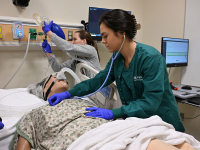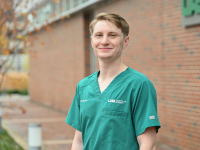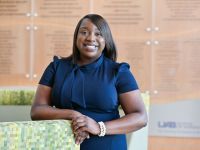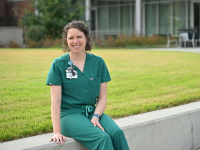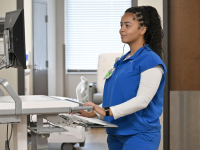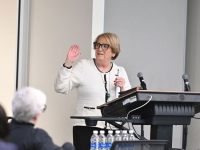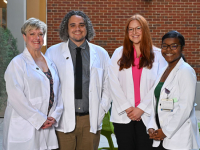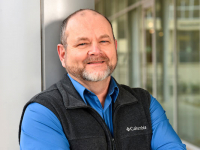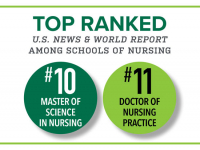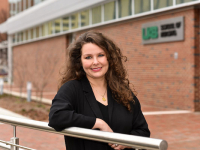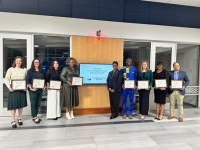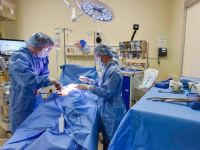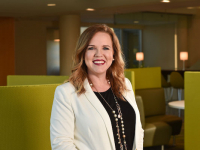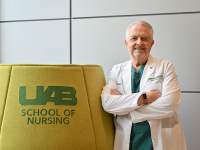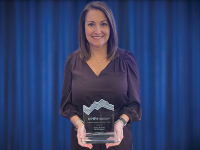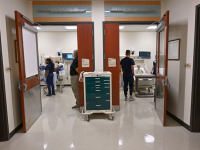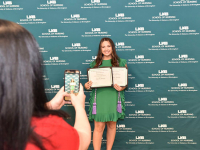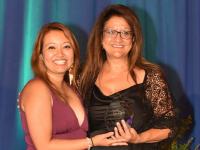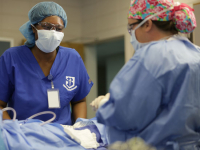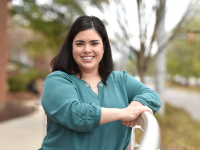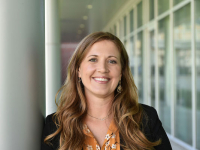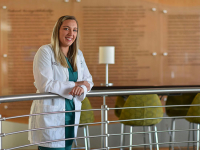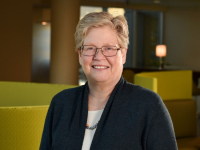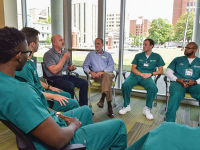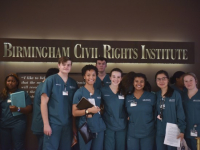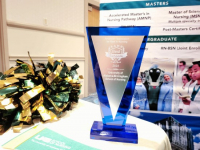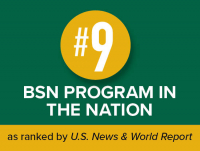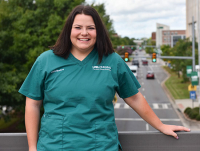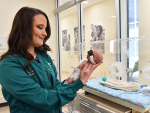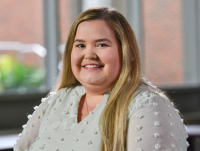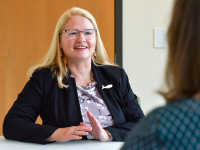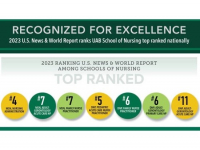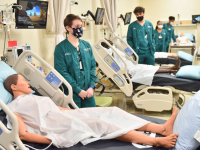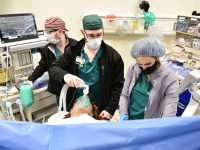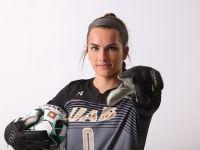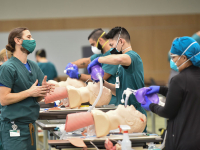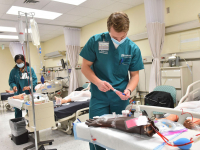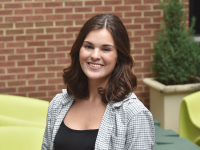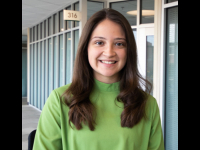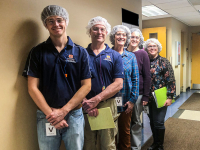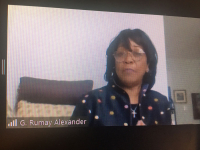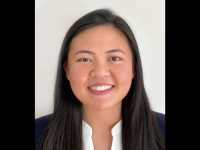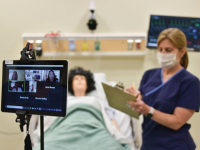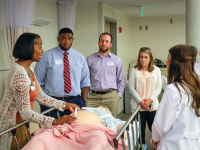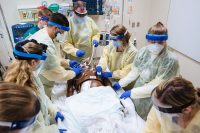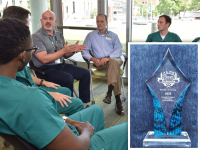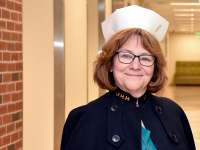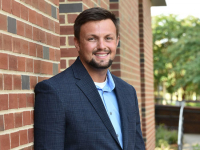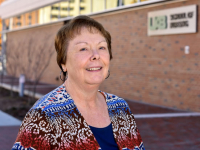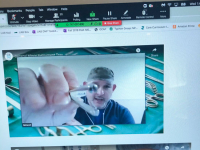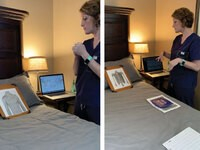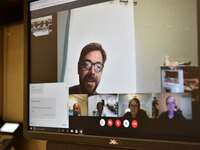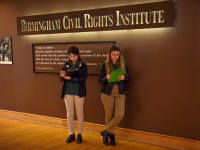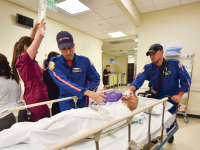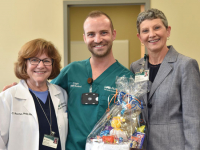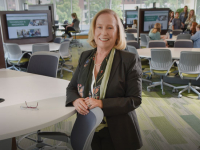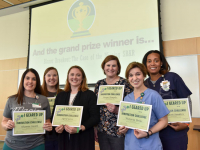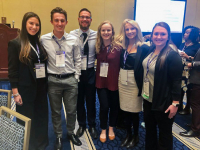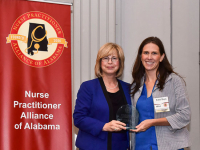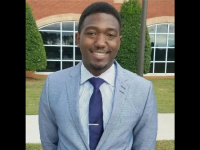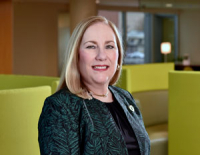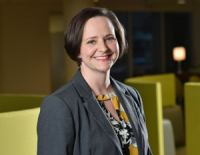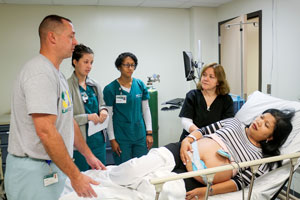 As the doctor in their patient advocate simulation speaks with his patient, Jasmine, and her doula, third-semester nursing students Leigha Lentini, left, and Stephanie Duncan survey the situation.The scenario was simple. Three University of Alabama at Birmingham (UAB) School of Nursing students were set to participate in a simulation to care for a 22-year-old woman named Jasmine who was 37 weeks pregnant and had come to the hospital because her delivery time was near.
As the doctor in their patient advocate simulation speaks with his patient, Jasmine, and her doula, third-semester nursing students Leigha Lentini, left, and Stephanie Duncan survey the situation.The scenario was simple. Three University of Alabama at Birmingham (UAB) School of Nursing students were set to participate in a simulation to care for a 22-year-old woman named Jasmine who was 37 weeks pregnant and had come to the hospital because her delivery time was near. What they didn’t know, however, was that just as with any real-life situation they may encounter down the road, circumstances were going to change.
In this case, the doctor who was scheduled to deliver Jasmine’s baby was nearing the end of his shift and had somewhere else to be soon afterwards so he was urging her to have a Cesarean section even though mother and baby were doing just fine. Jasmine was hesitant because she wanted an un-medicated birth and because her husband was in Atlanta and would not get to the hospital for several hours.
Suddenly the students found themselves in the middle of an uneasy situation with the patient wanting one thing and the doctor strongly recommending another. So what had started as an exercise in managing an uncomplicated labor and delivery had turned into one on patient advocacy and the responsibilities of a nurse in that capacity.
As the conversation continued, one of the students, Lavonna Parham from Birmingham, asked the doctor to step outside the patient’s room to discuss the situation and fellow student Stephanie Duncan from Austin, Texas, accompanied them. Outside the room, the discussion remained tense, as the students were firm in telling the doctor they believed the situation should be handled differently and the doctor equally firm in saying he believed his way was best.
Inside the room, student Leigha Lentini from Cullman was discussing options with Jasmine and her doula -- a nonmedical person who assists a woman before, during, and/or after childbirth – and reminding Jasmine that, if she and the baby were not at risk, it was ultimately her choice and not the doctor’s as to how her baby would be delivered.
When everyone was gathered in the room once again, Jasmine told the doctor she still wanted an un-medicated delivery, he agreed to consult with his partner coming on duty to have him do the delivery and the decision was made. Meanwhile, in a lecture hall across the way, the other members of the cohort, who had been watching the simulation by streaming video, cheered the efforts of their fellow students.
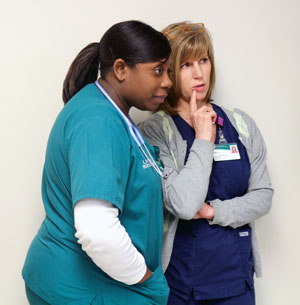 Instructor Kelly Dailey, right, and student Lavonna Parham discuss the proceedings during the immersive simulation on patient advocacy. “They were excellent at speaking up and responding to the patient’s needs,” said Instructor Kelly Dailey, MSN, RN. “They did a great job of talking to the doctor and sometimes that’s not easy for nursing students. It’s scary to talk to another health-care member when you are just starting out so I thought they did a great job of doing that.”
Instructor Kelly Dailey, right, and student Lavonna Parham discuss the proceedings during the immersive simulation on patient advocacy. “They were excellent at speaking up and responding to the patient’s needs,” said Instructor Kelly Dailey, MSN, RN. “They did a great job of talking to the doctor and sometimes that’s not easy for nursing students. It’s scary to talk to another health-care member when you are just starting out so I thought they did a great job of doing that.”It was one of 10 obstetrical simulations in which the cohort of third-semester nursing students participated that day, and each was designed to give the students a realistic feel for the career they have chosen. Each time, while three to four students took part in a simulation, the rest watched back in the classroom and then an extensive debriefing involving all the students took place afterwards.
It is this kind of hand’s-on training that makes the UAB School of Nursing such a great place to learn, said Duncan, a sergeant and medic in the United States Army pursuing her Bachelor of Science in Nursing at the School as part of the Veterans Career Advancement in Nursing (Veterans CAN!) program.
“At UAB they go out of their way to make sure that we have an experience that will leave a lasting impression on us,” Duncan said. “It’s not just ‘I learned that in nursing school’ it’s ‘I did that in nursing school.’ Being exposed to this kind of setting gives me confidence, and I am not even an RN yet.
“Now I will have that confidence when I need it, and it will happen I’m pretty sure because being an advocate doesn’t just involve the doctor. You might have a patient with a significant other or a spouse or a parent that wants you to do something and you have to advocate for the patient in that instance, too.”
The purpose of the simulations is to expose the students to situations and scenarios they may read about in their textbooks but not even encounter in their clinical rotations and to do it as realistically as possible. On this particular day, Jasmine was portrayed by Assistant Professor Sigrid Ladores, PhD, RN, PNP, who was actually 37 weeks pregnant at the time, one of many touches of realism that did not go unnoticed by the students.
“This simulation felt real,” Parham said. “Our patient was really pregnant. The person who played the doctor was on point. It really felt like we were advocating to get things done for our patient. At no point in time did this feel like a fake situation.”
The instructors who plan these immersive simulations strive to make sure each has a clinical foundation with the goal of allowing the students to practice what they have learned and experience the consequences of their decisions in a safe environment.
“They never know what they are going to encounter, but that is real life,” said Assistant Professor Cathy Roche PhD, RN, who has experience as a labor and delivery nurse in the UAB Health System and a free-standing clinic run by certified nurse midwives in Tampa, Fla. “When I get to the hospital and get ready to walk into a room, I might have gotten a brief report as to what I’m walking into, but other than that I don’t know. So I have to use my nursing skills to assess and figure it out, and that is what the students have to do in these simulations.”
| “At UAB they go out of their way to make sure that we have an experience that will leave a lasting impression on us. It’s not just ‘I learned that in nursing school’ it’s ‘I did that in nursing school.’ Being exposed to this kind of setting gives me confidence, and I am not even an RN yet.” |
“I will definitely be able to handle it better than if I had never had this simulation because I would have just been blindsided and not really known what to do,” Lentini said. “It will still be difficult if I ever have to deal with it in real life, but I will definitely have a better understanding and grasp of how to handle a situation like that because of this sim.”
Seeing the students perform as impressively as they did in this simulation is proof positive of their future abilities as nurses and of the immense value of the simulations as teaching tools for many different types of situations, Roche said.
“It makes me very proud to be faculty here to see how well students respond to situations and how they not only have learned mechanical nursing skills like starting IVs, but have the intuitive skills of knowing what’s right and what’s good for the patient and then being able to communicate those needs very professionally,” Roche said.
Based on the feedback they receive immediately after the simulations are complete and on down the road from students after they start their clinicals, the students are pleased that the School offers such dynamic, cutting-edge training as part of its curriculum.
“I hear it often that it is a great place for them to try the things they have read or heard about in the classroom,” Dailey said. “They’ll say ‘wow, this really helped me’ or ‘I had that same experience from simulation happen in clinicals.’ Offering immersive simulations is what’s new, and I think in order to be current in education, especially in nursing education, you must be providing simulation experiences.
"Our students begin simulation experiences in their first semester, and they perform simulations to the very end, right up until they graduate."

